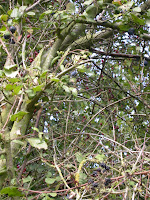Today we went on a walk around the village of Chartham, in Kent, UK. It is a designated Area of Outstanding Natural Beauty, which was quite apparent today ! Susan Hibberd was collecting ingredients for some more recipes taken from her book The Butterfly Book of Kentish Recipes.
available now from www.amazon.co.uk
We took some bowls with us, as we were on the look-out for blackberries. However, we seem to have jumped the gun a bit, and many of the blackberry bushes are still in flower, or have the fruits just forming. We did find some different fruits, though...
Gorgeous ripe elderberries hanging in bunches. The tree is very invasive, and you wouldn't want it in your garden, but the berries are rich in vitamin C and make a great jelly, with or without apples.
Gorgeous ripe elderberries hanging in bunches. The tree is very invasive, and you wouldn't want it in your garden, but the berries are rich in vitamin C and make a great jelly, with or without apples.
Elderberries. You can just see a few rose hips poking through the shiny black of the berries. These will be heated to release the juice, strained, mixed with apple juice and made into jelly.
Sloe bushes have nasty prickles, so be careful how you pick them.
Some gorgeous sloes, just crying out to be mixed with sugar and soaked in gin. These were so ripe they fell off the tree when we shook it.
See how the hop vine uses the hedge to support itself.
Here are some hops that have escaped from the hop fields and set themselves in a hedgerow.
Sweet chestnut. When the nut is ripe, it will fall to the floor, splitting the spiny casing. These are quite different from the horse chestnuts that are used as conkers.
Haws from the hawthorn, or may, tree. These can be added to hedegrow jelly, but have lots of pips so are unsuitable for jam.
Gorgeous ripe bullaces with a lovely bloom on them. We shook the tree and they just fell off !
Rose hips for jelly.
Rose hips from a different type of rose. These hips are larger. Rose hips have horrible large, hairy seeds that need to be removed,but once boiled and sieved, can be used to make syrup or jelly.
Jars of rosehip syrup ready to add to lemonade or pour over ice cream. A recipe for Rose Hip Jelly appears in The Butterfly Book of Kentish Recipes.
It's been a bad year for blackberries where we live in Kent. Here is a little bunch of blackberries, some ripe and some half ripe. The lack of rain means they are not plump and juicy like they should be at this time of year.
THESE ARE THINGS YOU SHOULD NOT EAT:
Horse chestnuts. The picture on the right shows the chestnuts on the tree, just beginning to split open. the ones on the left must have fallen quite recently, as they are still shiny. They quickly lose their shine once they are exposed to the air. Children tie the dried chestnuts to string and play 'conkers; with them, taking turns to hit each others' nut. The one that doesn't break is the winner. Apparently, soaking them in vinegar makes them harder.These chestnuts are quite different from sweet chestnuts and are poisonous.
A super formation of fungus. I don't know the type Never eat any fungus unless you know what it is.
These holly berries are on a variegated bush, and are quite spectacular. Great for decorating your home, especially at Christmas time, but don't eat them !
A fantastic result! Kentish Red Cherries scrumped from a roadside hedgerow. They are really tart and can't be eaten fresh, however, they are great for sauce or jam.
From late April onwards the foamy clusters of elderflowers dot the hedgerows. These can be used immediately to make fresh elderflower fritters using a light batter, or added to preserves. They make a great addition to gooseberry jam or jelly, giving it a really delicious and different taste.
In an abundant year, the flowers can be used to make elderflower cordial or elderflower wine, an old country favourite.
Check out some recipes that use these great Kentish ingredients in The Butterfly Book of Kentish Recipes. More information on this blog,or on www.amazon.co.uk
+front+only.jpg)



























No comments:
Post a Comment